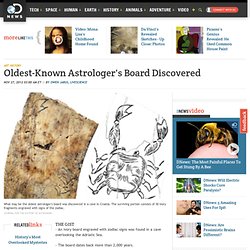

Airship Plan to Put Cameras in the Sky. An ambitious plan by a Croatian startup would see airships return to the skies, not carrying passengers, but as autonomous unmanned airborne vehicles (UAVs), maintaining a permanent watch.
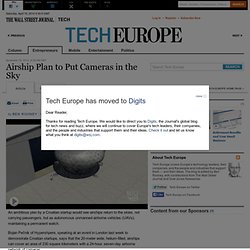
Bojan Pečnik of Hypershpere, speaking at an event in London last week to demonstrate Croatian startups, says that the 20-meter wide, helium-filled, airships can cover an area of 230 square kilometers with a 24-hour, seven-day airborne network of cameras. But this is no spy-in-the-sky plan to watch our every move, says Mr. Pečnik. Rather his plan is to use the UAVs as a platform, opening up the data feed to allow people to build apps using the data. Who would use it? “We are currently in talks with the Croatian police about border monitoring.” American Society for Biochemistry and Molecular Biology honors outstanding Scientists. American Society for Biochemistry and Molecular Biology honors outstanding Scientists Ivan Dikic will receive the William C.

Rose Award 2013 FRANKFURT. Prof. Surprisingly Sophisticated Palaeolithic Pottery Found in Europe. By Cassie RyanEpoch Times Staff Created: July 25, 2012 Last Updated: July 25, 2012 Leg and torso from the model of a four-legged animal, possibly a deer or horse.
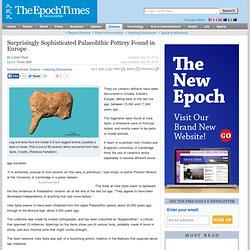
This is one of 36 ceramic items recovered from Vela Spila, Croatia. (Rebecca Farbstein) Thirty-six ceramic artifacts have been discovered in Croatia, Eastern Europe, dating back to the last ice age, between 15,000 and 17,000 years ago. The fragments were found at Vela Spila, a limestone cave on Korcula Island, and mostly seem to be parts of model animals. A team of scientists from Croatia and England’s University of Cambridge think the use of ceramics arose separately in several different stone age societies.
“It is extremely unusual to find ceramic art this early in prehistory,” said study co-author Preston Miracle at the University of Cambridge in a press release. First Epigravettian Ceramic Figurines from Europe (Vela Spila, Croatia) Recent finds of 36 ceramic artifacts from the archaeological site of Vela Spila, Croatia, offer the first evidence of ceramic figurative art in late Upper Palaeolithic Europe, c. 17,500–15,000 years before present (BP).
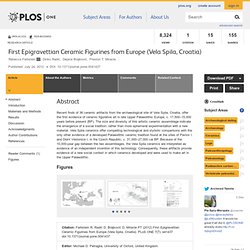
The size and diversity of this artistic ceramic assemblage indicate the emergence of a social tradition, rather than more ephemeral experimentation with a new material. Vela Spila ceramics offer compelling technological and stylistic comparisons with the only other evidence of a developed Palaeolithic ceramic tradition found at the sites of Pavlov I and Dolní Věstonice I, in the Czech Republic, c. 31,000–27,000 cal BP. Because of the 10,000-year gap between the two assemblages, the Vela Spila ceramics are interpreted as evidence of an independent invention of this technology. Consequently, these artifacts provide evidence of a new social context in which ceramics developed and were used to make art in the Upper Palaeolithic. Figures Editor: Michael D. Introduction Results. Egyptian mummy shows signs of rare disease.
In Photos: A Look Inside an Egyptian Mummy. Andrija Mohorovičić. Andrija Mohorovičić (Croatian pronunciation: [ǎndrija moxorǒʋitʃitɕ]) (January 23, 1857 – December 18, 1936) was a Croatian meteorologist and seismologist.

He is best known for the eponymous Mohorovičić discontinuity and is considered a founder of modern seismology.[1][2] Early years[edit] The house in Volosko where Mohorovičić was born. Mapping the Moho with GOCE. Global Moho from GOCE Mapping the Moho with GOCE 9 March 2012 The first global high-resolution map of the boundary between Earth’s crust and mantle – the Moho – has been produced based on data from ESA’s GOCE gravity satellite.
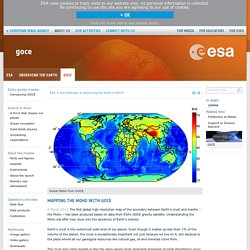
Understanding the Moho will offer new clues into the dynamics of Earth’s interior. Earth’s crust is the outermost solid shell of our planet. The crust and upper mantle is also the place where most geological processes of great importance occur, such as earthquakes, volcanism and orogeny. Improving Moho modelling Until just a century ago, we didn’t know Earth has a crust.
Ever since, that boundary between Earth’s crust and underlying mantle has been known as the Mohorovičić discontinuity, or Moho. Even today, almost all we know about Earth’s deep layers comes from two methods: seismic and gravimetric. Seismic methods are based on observing changes in the propagation velocity of seismic waves between the crust and mantle. Moho and gravity. Gravity Field and Steady-State Ocean Circulation Explorer. The Gravity Field and Steady-State Ocean Circulation Explorer (GOCE) was the first of ESA's Living Planet Programme satellites intended to map in unprecedented detail the Earth's gravity field.

The spacecraft's primary instrumentation was a highly sensitive gravity gradiometer consisting of three pairs of accelerometers which measured gravitational gradients along three different axes. After running out of propellant, the satellite began dropping out of orbit and made an uncontrolled reentry on 11 November 2013.[1] Discoveries and applications[edit] Mission objectives[edit] Gravity map and model[edit] The final gravity map and model of the geoid will provide users worldwide with well-defined data product that will lead to: Findings[edit] The first Earth global gravity model based on GOCE data was presented at ESA’s Living Planet Symposium, in June 2010.[3] Operations[edit] Launch[edit] Operation[edit] Microsoft Announces Four Imagine Cup Grant Winners in Inaugural Year. Today, we’re announcing the four teams that have been selected as the inaugural Imagine Cup Grant winners!

Starting today, these students will continue their journey of transitioning their Imagine Cup project into a startup business or nonprofit organization with support from Microsoft as well as on the ground connections they will soon make. It’s no secret that Imagine Cup students are changing the world. Since the competition’s launch in 2003 we’ve seen student inventions make a real impact in a variety of ways, from disaster relief efforts in Haiti and Japan, to revolutionizing student participation in the classroom, to helping with stroke rehabilitation for the elderly. Without further ado, here are your Imagine Cup Grants winners! Team Apptenders from CroatiaTeam Members: Ivan Antonic, Ivan Borko, Karmela Bresan, Dominik Tomicevic Project Description KiDnect is a Kinect-based solution for on-premise and remote physical therapy for children, especially those born with Cerebral Palsy.
Imagine Cup Grant Video Team Apptenders from Croatia. Oldest-Known Astrologer's Board Discovered. - An ivory board engraved with zodiac signs was found in a cave overlooking the Adriatic Sea.
